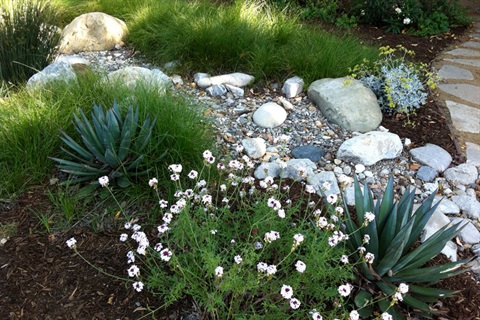How To Build a Dry River Bed

A dry river bed or dry stream is an area designed to slow heavy flows of water from rainfall and correct erosion problems. It is made up of a shallow swale (see section on vegetated swales) lined with stone substantial enough to withstand a serious downpour. Large chunks of stone are used to slow the speed of storm water and prevent erosion. In a garden, the careful placement of water-worn stone, or river slicks along a swale can be a beautiful design that also provides an ideal place for plants. The dry river bed or stream should have enough of a side slope that the difference between level ground and the lowest point in the dry river bed is visible to the eye.
Follow these steps to create a beautiful dry river bed:
- Choose the placement of the dry river bed. The dry river bed should take a curvy course down a sloped portion of your landscape leading run-off water away from troublesome areas, towards plants or your drainage system. Keep in mind that dry creeks are usually twice as wide as they are deep when plotting out the area of your dry river bed.
- Dig your dry river bed. Following the 2:1 depth and width ratio above, dig your dry river bed trench and mound the soil on the sides of the river bed to create walls around the bed. These walls are called berms, and will ensure that water remains in your rain garden during a storm instead of flooding the rest of your landscape. Stomp the berms firmly down to ensure the walls are sturdy.
- When the trench is the size you would like it, place landscape fabric along the river bed and its walls. Anchor the landscape fabric with fabric pins or garden staples.
- Place stones in your dry river bed. Use rocks of various shapes and sizes in the river bed. Larger stones should be placed on the sides of the trench and small stones in the middle of the trench to encourage water flow through the middle of the dry river bed.
- Beautify the dry river bed. To prevent the soil walls around the creek bed from eroding, plant native shrubs and plants with strong root systems.
Helpful Tips:
- At the beginning of each rainy season check the stones in the dry river bed to ensure that water can still freely pass between them. Remove any trash or debris from the creek bed as necessary.
- Water your plants regularly for the first 90 days and in times of drought to ensure their root systems grow into sturdy anchors for the dry river bed walls.
Helpful Links:
Tips for Installing a Rock-Lined Swale (pdf)